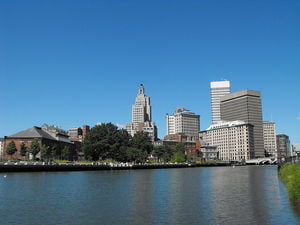Benito Mussolini, born July 29, 1883 in Predappio, Italy, was raised in a socialist form of government (Mussolini, Benito, 2006). As a young man, Mussolini lived in Switzerland between 1902 and 1904 in order to avoid serving in the military. Upon his return to Italy, he arose to prominence through his opposition to the Libyan war. He worked as an editor for Italy’s socialist newspaper, but the paper terminated his employment during World War I, at which time he embraced nationalism (Mussolini, Benito, 2008).
Mussolini founded another newspaper entitled, “Popolo d’Italia,” which was financed by France, in the hopes that Italy would enter the war on the side of the allies. Mussolini joined the Italian army in 1915 and attained the rank of corporal (Mussolini, Benito, 2008).
After the war, Italy experienced some unrest, as socialism was failing as a political system. Mussolini organized among his peers (mostly veterans) and formed a strong nationalist movement. He rallied the public with strong persuasive speeches the idea of restoration and he employed terrorist techniques with armed followers enforcing what he spoke about and quelling less organized resistance (Mussolini, Benito, 2008).
Mussolini became popular with the people as a dictator because he restored order to the country and brought about social reforms and public works improvements (Mussolini, Benito, 2006). Perhaps his success, massive public support, and appreciation inspired him to attempt to expand his “empire”, but he failed in his attempt in Northern Africa (Mussolini, Benito, 2008).
His alliance with Adolf Hitler, which people associated with massive genocide and other war crimes, most likely was the turning tide of public support. Hitler put pressure on him to establish an anti-Semitic policy, which was very unpopular among the Italian populace. When the German holdings in Italy collapsed, the Italian people captured Mussolini, tried him, and executed him by firing squad, along with his mistress, Clara Petacci. Both of their bodies were publicly displayed and then buried in unmarked graves. Approximately twelve years later, Mussolini’s body was exhumed and entombed in a family plot (Mussolini, Benito, 2008).
Adolf Hitler became the leader in Germany in the 1930 and continued as the leader in Germany until his death in 1945. Hitler served in the Army during World War I and attained the rank of Corporal. After Germany surrendered, Hitler, as well as many of the German citizens placed the blame for failure on Jewish people and other groups, including those adopting communism as a political party (Hitler, Adolf, 2002).
Hitler joined the “German Worker’s Party” in 1919 and within a year he took over leadership of the party and renamed it the “National Socialist German Worker’s Party.” Having signed the Treaty of Versailles, Germany agreed to pay billions in reparations to the allies and this severely crippled the nation’s economy. (Hitler, Adolf, 2002).
Hitler attempted a takeover of German government, employing guerilla and terrorist tactics, but the Munich police quelled the uprising and captured Hitler, tried him for treason, and sentenced him to five years in prison. While Hitler was in prison, he wrote “Mein Kampf”, which defined his Nazi ideals and proposed a plan of purification of Germany and the rest of the world of Jews and those of an impure race. The government gave in to political pressures and released Hitler after he had served nine months of his sentence (Hitler, Adolf, 2002).
With Germany’s economy and political systems in recession, people began to listen to Hitler as he rallied for the rebuilding of Germany. Hitler also garnered public support of the idea of reneging on the terms of the Treaty of Versailles. Hitler obtained the office of Chancellor and through manipulation; he created the transition from democracy to dictatorship. He abolished all other political parties and labor unions. Being the first leader in modern history to understand the importance of mass media, for which he formed a propaganda administration that controlled the various media channels (Hitler, Adolf, 2002).
Hitler mandated laws that created hardships for Jews, effectively stripping them of any civil liberties. Soon after, Hitler created mass concentration camps where he imprisoned all Jews and anyone that may have deemed a threat to his political ideals. Hitler broke the terms of the Treaty of Versailles by ceasing to pay any more in reparations and he reclaimed the Rhineland. He rebuilt the German army and annexed Austria (Hitler, Adolf, 2002).
At a meeting in Munich, France and Great Britain agreed to take no action against Hitler as long as he did not continue with his expansion. Hitler interpreted the Munich agreement to understand that if he continued his expansion that Great Britain and France would not take any further actions, thus he invaded Czechoslovakia and annexed that country. Hitler’s invasion of Poland on September first of 1939, France and Great Britain finally reacted and World War II began, which lasted through 1945 (Hitler, Adolf, 2002).
Hitler’s invasion of his main ally, Russia, became his undoing. With Russia fighting Germany from the east and the United States and Great Britain from the west, the forces of Germany began to weaken (Hitler, Adolf, 2002). Seeing the end of his empire, Hitler married Eva Braun in Berlin on April 29, 1945, in an underground bunker. The following day, April 30, they both committed suicide (Hitler, Adolf, 2006).
Joseph Stalin was born Losiv Vissarionovich Dzhugashvili on December 21, 1879 in Gori, Georgia of the Russian Empire. He went to seminary school with the intention of becoming a priest, but the school expelled him in 1889 for his participation with revolutionary activities. Stalin joined an underground revolutionary group and served in different positions, working his way up through the ranks (Stalin, Joseph, 2006).
Stalin experienced a continuous pattern of arrests, imprisonment, and exile for his increasingly aggressive revolutionary activities during his young adult years. Perhaps to mask his arrests and affiliation with his radical activities, he officially changed his name to Stalin in 1910. He joined the Bolshevik movement under Vladamir Ilich Lenin about the same time. Stalin’s next arrest resulted in exile to Siberia, where he remained during World War I (Stalin, Joseph, 2002).
Stalin returned in 1917 and worked closely with Lenin to establish the communist political state and fighting a three-year civil war against those who still supported a democracy. When Lenin died in 1924, Stalin methodically worked towards the principle leader (dictator) of Russia. Stalin finally prevailed as dictator over Russia in 1929 (Stalin, Joseph, 2002).
As Stalin became stronger in his position of leader of Russia, he directed assignation plots and had others arrested on phony criminal charges. His enemies, real or imagined, were subjected to torture until they made false confessions in court. Stalin imprisoned millions of people for being disloyal to his cause (Stalin, Joseph, 2002).
Stalin allied himself with Nazi Germany in 1939, entering in a nonaggression pact. Immediately following, Germany invaded Poland and the Soviet Union invaded Eastern Poland. In 1940, the Soviet Union invaded Lithuania, Latvia, and Estonia. Stalin was unprepared when Hitler invaded the Soviet Union in 1941, however the harsh winter that same year thinned out the Nazi’s military, and the German army was driven back. At this time, Stalin aligned the Soviet Union with the United States and Great Britain and together the force of the three countries defeated Germany in 1945, brining a close to the war in the European theatre (Stalin, Joseph, 2002).
Following the conclusion of World War II, the Soviet Union and the United States became locked into the Cold War, which lasted for nearly a generation after Stalin’s death. Joseph Stalin died from a brain hemorrhage on March 5, 1953. This ended the Stalin era in the history of the Soviet Union, but his legacy lived on with subsequent leaders of the country (Stalin, Joseph, 2002).
References:
Hitler, Adolf. (1889 – 1945). (2002). In World of Criminal Justice, Gale. Farmington, MI: Thomson Gale. Retrieved February 4, 2009, from http://www.credoreference.com/entry/4827772/.
Hitler, Adolf. (2006). In Britannica Concise Encyclopedia. Chicago, IL: Encyclopedia Britannica. Retrieved February 5, 2009, from http://www.credoreference.com/entry/6716509/.
Mussolini, Benito. (2008). In the Columbia Encyclopedia. New York, NY: Columbia University Press. Retrieved February 3, 2009, from http://www.credoreference.com/entry/8286769/.
Mussolini, Benito (Amilcare Andrea) known as Il Duce. (2006). In Britannica Concise Encyclopedia. Chicago, IL: Encyclopedia Britannica. Retrieved February 3, 2009, from http://www.credoreference.com/entry/6716823/.
Stalin, Joseph [Iosif li Vissarionovich Dzhugashvi] (1879 – 1953). (2002). In World of Criminal Justice, Gale. Farmington, MI: Thomson Gale. Retrieved February 06, 2009 from http://www.credoreference.com/entry/4828232/.
Stalin, Joseph orig. Iosif Vissarionovich Dzhugashvili. (2006). In Britannica Concise Encyclopedia. Chicago, IL: Encyclopedia Britannica. Retrieved February 06, 2009 from http://www.credoreference.com/entry/6717150/.


